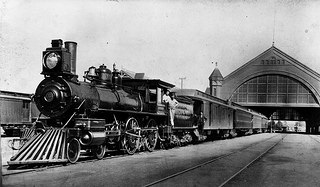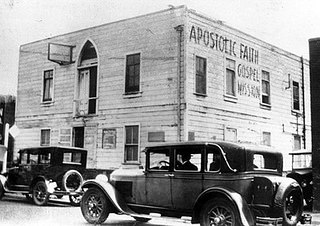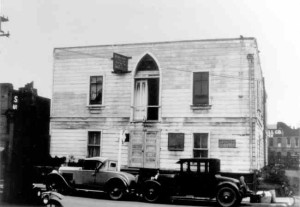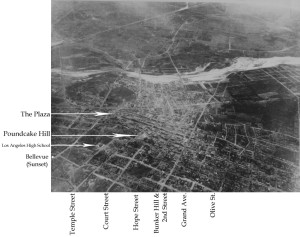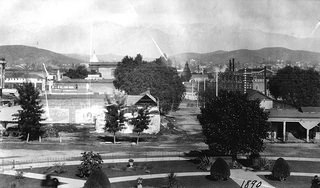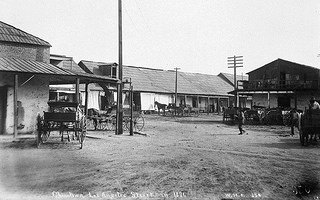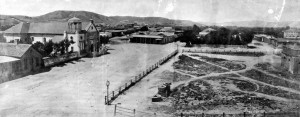The Arcade Station
In 1887, the still-standing Wolfskill Adobe would be razed to make way for the old Southern Pacific Railroad's Arcade Station, which was located at Fifth and Alameda and a few blocks from Azusa Street. This, too, would be demolished in 1914 and replaced with a larger and more modern railroad passenger depot - the Central Station. This station influenced business developement and population growth around the nearby Azusa Street and downtown Los Angeles.
The Arcade Station was the second station built by Southern Pacific in Los Angeles (and first one built primarily for ...
Flooding at 312 Azusa Street
A massive flood in the late 1880s severly damages downtown Los Angeles. 312 Azusa Street home is serverly damaged and is left condemned for several years, but found new life when William James Seymour was invited to be a pastor for the newly formed Black Holiness Church at this site in 1906. Seymour opened the historic meeting in April of 1906 and the Azusa Street Revival began. The Azusa Street Revival is credited by many to be the birthsite of the Pentecostal movement. In just over 100 years, Pentecostalism has grown to have 500 million followers.
312 Azusa Street Building is Constructed
Stevens African Methodist Episcopal Church constructs a 40 feet by 60 feet church building at 312 Azusa Street. Inspired by a vision from God to establish a church that would minister to the mind, body and soul of all who would join, Biddy Mason funded the construction with her son-in-law, Charles Owens.
Los Angeles in 1877
Floating some 9,000 feet above the city in a hot-air balloon in 1887, Edwin H. Husher took what may be the first aerial photo of Los Angeles.
By 1887, the City's population had grown to over 20,000 people with most of the new development having taken place south of the original Pueblo and LA Plaza as seen in the above photo.
Aerial photo of Los Angeles looking East on June 27, 1887 taken from a balloon. Note the farmland south of Second Street and east of Main Street to the Los Angeles River. The circular form of the Plaza is visible to the center left.
The Grand Opera House
The first auditorium built in Los Angeles was the Grand Opera House, located on Main Street by First Street, just a few blocks from Azusa Street. It was built by Orzo W. Childs, had 1800 seats, and dedicated on May 24, 1884. It was first called Child's Opera House, named after Mr. Childs. Mr. Childs was a horticulturist and one of the civil leaders who provided land to University of Southern California, which created an endowment to fund the establishment of their campus.
Olvera Street forms
After the Mexican-American War, the Plaza remained the center of El Pueblo. A small alley branching off of the Plaza—Wine Street—had its name changed by City Council ordinance in 1877 to Olvera Street to honor Augustín Olvera, the first Superior Court Judge of Los Angeles County, who owned an adobe house nearby. Over time, Olvera Street became a marketplace, with cafes, street vendors, and shops, and still exists about one mile from Azusa Street. The image on the left shows is from 1890, looking north across the L.A. Plaza to the beginning of Olvera Street. The Olvera ...
The Chinese Massacre
The Chinese Massacre of 1871 was a racially motivated riot on October 24, 1871 in Los Angeles, when a mob of over 500 men entered Chinatown to attack, rob and murder Chinese residents of the city. The riots took place on Calle de los Negros, which later became part of Los Angeles Street. A total of 18 Chinese immigrants were systematically killed by the mob, making the so-called "Chinatown War" the largest incident of mass lynching in American history.
Bible Study becomes a Church
Biddy Mason establishes a bible study in her home in Los Angeles, California, that becomes Stevens African Methodist Episcopal Church and is currently know as the First African Methodist Episcopal Church. The picture on the right is an image of Biddy Mason's home on First Street in the 1870s, which is a few block away from Azusa Street. In the late 1800s, it was common to for bible studies to form, grow, and transition into a congregation that founds a church site.
William J. Seymour
William Joseph Seymour was a minister and the prominent leader of the Azusa Street Revival, which many contribute to the birth of the Pentecostal movement. In 1972, Sidney Ahlstrom, a church historian of Yale University, stated that Seymour was "the most influential black leader in American religious history." He was born in Centerville, Louisiana in 1870 and moved to Los Angeles in 1906, where he lived and preached until his passing in 1922.
Los Angeles’s Population in 1870
In 1870, the population of Los Angeles was 5,730. The panoramic view of 'the Plaza' (La Placita) and the 'Old Plaza Church' (Mission Nuestra Senora Reina de Los Angeles). The square main brick reservoir in the middle (partial view) was the water reservoir builit by William Dryden and his LA Water Works Co. to collect water from the 'mother ditch' (Zanja Madre). The image was taken in 1869.


